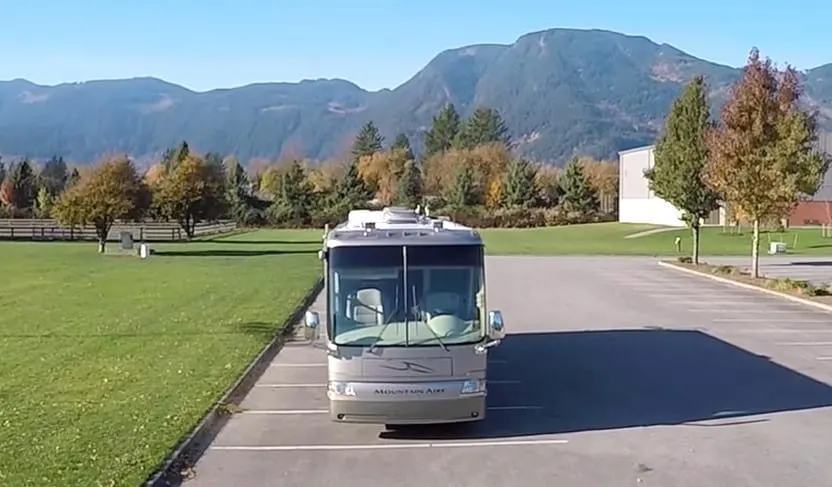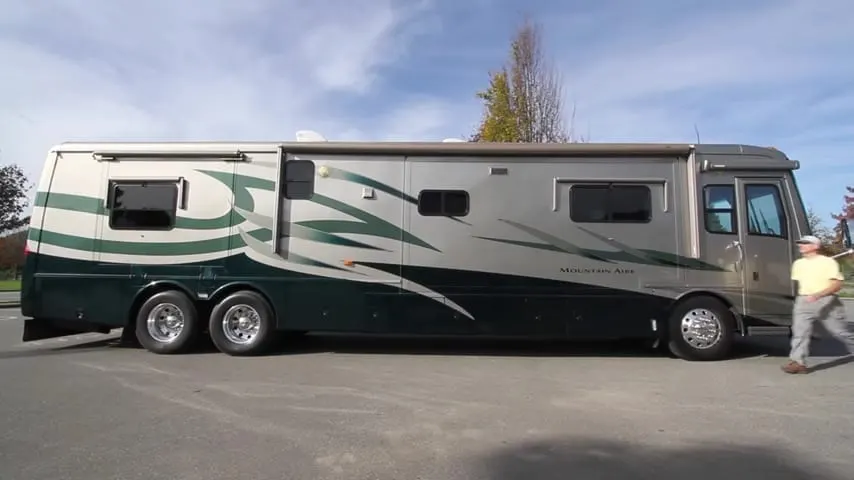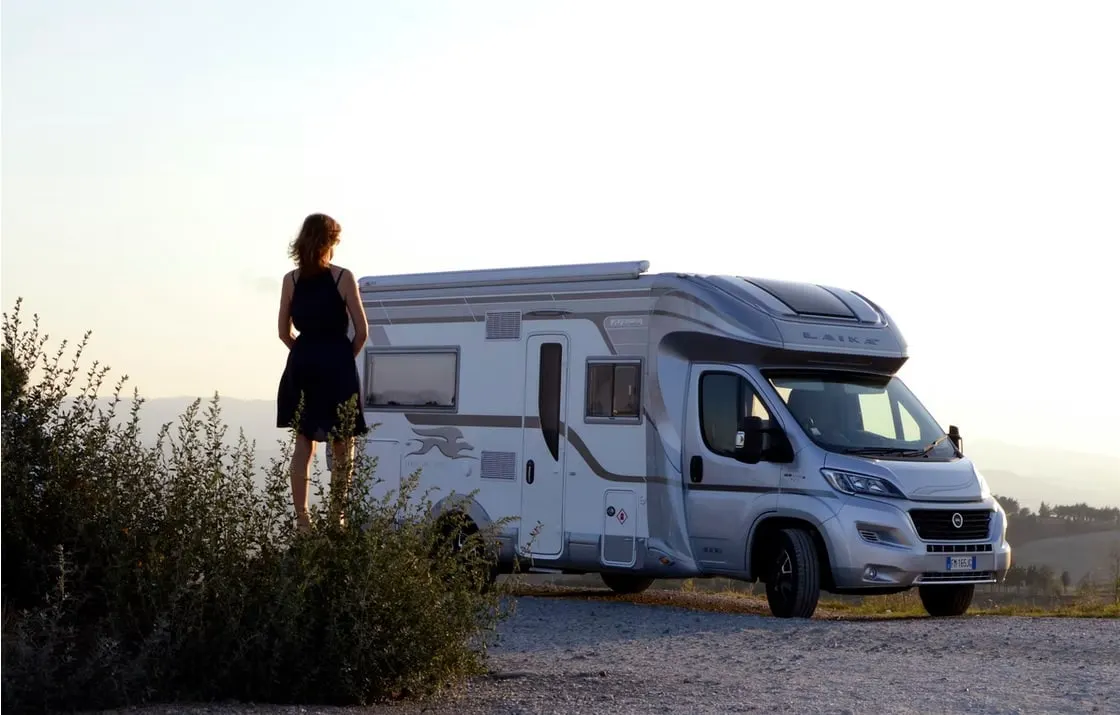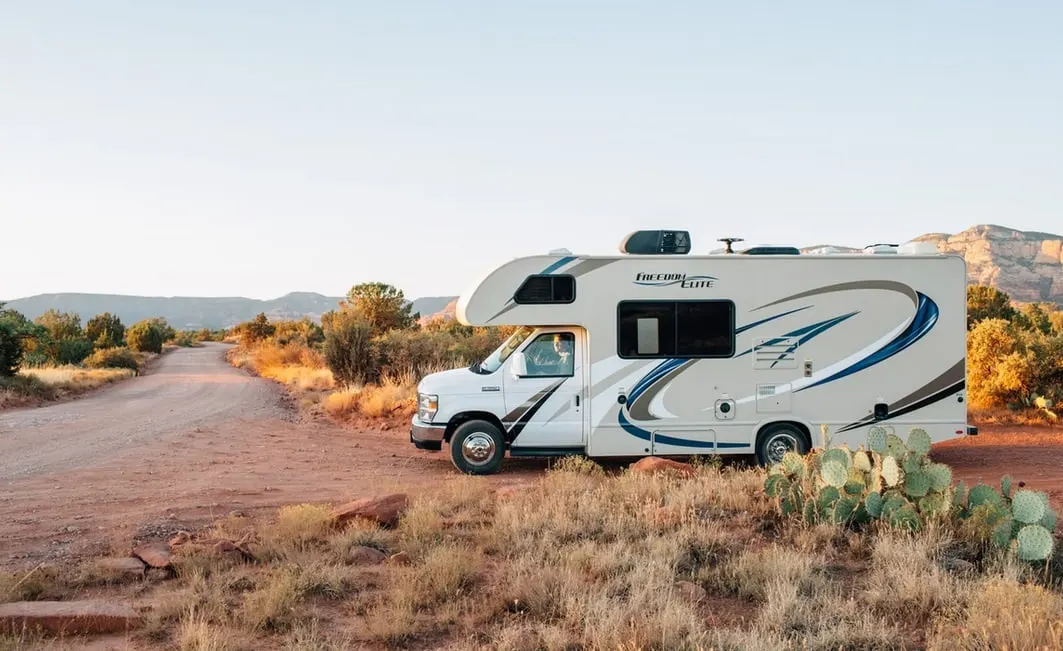Whether your RV is a smaller Class B, a Class C, or a large Class A rig like ours, backing up a motorhome can be a concern for every RVer. Backing up a Class B van is undoubtedly far more manageable than backing up a Class A motorhome, but backing up a motorhome of any size or type probably isn’t high on anyone’s list of things to do just for fun.
We travel in a 43-foot Class A diesel pusher, so we understand the challenges that can come with backing up a larger rig. Although after nearly two decades on the road, it’s something we’ve done hundreds, if not thousands, of times.
We’ve also got an award-winning professional big rig driver on board, so we admit to having an advantage. All the more reason we’re happy for Peter to share seven pro tips for backing up a motorhome that we hope will be helpful to you. Let’s get to it.
- 1) How Do You Back Up a Motorhome?
-
2)
7 Pro Tips to Follow When Backing Up a Motorhome
- 2.1) TIP 1 – Take a Mental Picture
- 2.2) TIP 2 – Use ALL of Your Tools When Backing Up Your RV
- 2.3) TIP 3 – Don’t Be Driven By Pressure
- 2.4) TIP 4 – Beware of Reverse Off-Tracking When Backing an RV Around a Corner
- 2.5) TIP 5 – Whenever Possible, Back to the Left When Backing Up a Motorhome
- 2.6) TIP 6 – Line Yourself Up While Still Rolling Forward
- 2.7) TIP 7 – Pay Attention to Your Right Quarter Vision When Backing Up an RV
- 3) Conclusion: You Can Handle Backing Up A Motorhome
How Do You Back Up a Motorhome?
Very carefully! But seriously, backing up a motorhome – even backing up a Class A motorhome – is like anything else we learn to do well – it requires practice and practice.
If you’re just learning how to back up a motorhome, try finding a large, open, empty parking lot, and spend some time getting a feel for the following tips. As you begin your practice sessions, be sure not to position yourself near objects that could cause damage to your motorhome or anything in the area. You want to give yourself as much freedom as possible as you master the tips about backing up a motorhome.

Finding a local parking lot where you can practice backing up your motorhome (preferably when the lot is empty) will help instill confidence and muscle memory.
While we understand that backing up a motorhome can be intimidating for many reasons, we’re confident that you’ll become more at ease with the process with practice, and the mastering of these tips. Even if you’re backing up a Class A motorhome, the more you understand about the process, the easier it will be.
7 Pro Tips to Follow When Backing Up a Motorhome
TIP 1 – Take a Mental Picture
Before backing up a motorhome, take a “mental picture” of the area you’re about to back into. As you’re driving forward to position yourself to back into a site, for example, slow or stop, and look into the area, making a mental note of any and all obstacles.
Remember that you’re tall, so think in three dimensions, looking for trees, poles, etc. If necessary, stop the RV and get out to walk the site before backing up the motorhome, again taking note of everything that might be an obstacle.
Extra Pro Tip: Know in advance how to pace off your rig’s length. For example, I know that I pace off exactly 14 steps plus one foot (one of my feet) to equal the length of our motorhome. As a result, I can enter walk into any site and know if we’ll fit, even before bringing the rig into the campground.

Peter knows that he paces exactly 14 steps plus one foot to equal the length of our motorhome. So he can walk into a campground before ever pulling the RV in and pace off the area to establish whether or not our rig will fit into a site.
Again, if you’re unsure about anything at any point, get out and look before backing up your motorhome (better known by the acronym G.O.A.L. by professional drivers everywhere).
Take that mental picture of everything there, and pace off the site if you’re not sure it’s long enough.
TIP 2 – Use ALL of Your Tools When Backing Up Your RV
When backing up a motorhome, it’s important to use EVERY tool at your disposal: All mirrors, both flat and convex, your windows (yes, if your driver’s window allows it, you can stick your head out while stopped), a spotter (if available), and your backup or side-view cameras (again, if available). Be sure to check out our complete post on how to adjust RV mirrors.
If things are really tight, and you don’t have a spotter, don’t be afraid to ask someone for help. If it’s just too tight, consider another route (approaching from the opposite direction), or even another site altogether. Usually, approaching a site that requires backing is easier from one side vs the other.
A note of caution about spotters: A well-intentioned “helpful” stranger, with whom you have no real rapport or understanding, can back you into something (especially an obstacle that’s high up that they may not think to look for, like a tree limb). While they may mean well, you’ll be the one who’s left to deal with the damage. So choose your spotter carefully.

A spotter with whom you have practiced, have a rapport, and share “backing language” is ideal. But if you need to ask a stranger to help, be very careful to choose someone with experience backing a large vehicle similar to yours if at all possible.
For example, if you’re backing up a Class A motorhome, you may not want to choose a neighbor with a Class B van to back you if there are folks a few campsites over with a Class A motorhome. So again, experience appropriate to the rig you’re backing up is most helpful.
If you have a traveling companion, formulating a language that you both understand well before backing up a motorhome at a campsite can be very helpful. Hand signals should be clearly understood, and walkie-talkies are often even better! Be sure to take that partner along with you for some parking lot practice!
TIP 3 – Don’t Be Driven By Pressure
Never let pressure, nerves, or anyone else drive your RV for you. That means that if you’re trying to maneuver in a tight spot and you’re not 100% sure that you’re clear of that power pedestal or tree or picnic table… stop! Don’t continue moving just because stopping and getting out to look will block the campground roadway or make other campers think you don’t know what you’re doing.
First of all, they’re strangers, so who cares what they think of you as you’re backing up a motorhome. Second, anyone who’s had experience backing up a motorhome, and in particular backing up a big Class A RV, knows that it can be a delicate process, especially when things are tight. They’ll also understand that nothing is more important than avoiding contact with a fixed object or other obstacle.
We’ve seen more accidents where drivers were too embarrassed to simply stop, get out of the rig, and evaluate the situation. And all because people were watching them.
It’s ultimately far more embarrassing to succumb to pressure, appear cavalier, and hit something that causes damage to your rig, someone else’s rig, and/or a part of the campground than it is to GET OUT OF YOUR RIG and size up the situation from outside the RV, and THEN resume backing up your motorhome safely.
TIP 4 – Beware of Reverse Off-Tracking When Backing an RV Around a Corner
When backing up a motorhome around a corner (or any other time you’re not rolling perfectly straight back) beware of something called “Reverse Off-Tracking.” If you have a look at our first driving video about Off-Tracking and Rear Overhang, you’ll note that there’s a seldom-discussed related danger when backing up, and you need to be aware of it.
When backing up a motorhome with the wheel turned to the right, the left side of the rig sweeps out to the left, basically moving diagonally/sideways. Even though you’re sitting right there in the driver’s seat on the left side, it’s easy to forget about that sweep. This could allow you to strike an obstacle with your left side, right down below or behind the driver’s seat, unless you remember to monitor the convex mirror and/or out your left window.
I always open my driver’s window when maneuvering back into a site for just this reason. I can stick my head out to look straight down and along the left side of the rig if needed. That’s especially important when items are low and/or close along the left side (like the picnic table in the neighboring site, for example). The open window also allows me to hear better, including instructions from my spotter.
Of course, you can’t as easily look down along the right side, or stick your head out the right window (at least in North America, or other countries where we sit on the left side of the vehicle). That makes the right front corner one of the most vulnerable spots when backing. That’s why I’ll sometimes position my spotter near the entrance door when maneuvering backward in a very tight site with an obstacle close to the right front corner of the RV.
It may seem like behind the RV is where your spotter belongs, but that isn’t always the case!
When backing up a motorhome with the wheel turned to the right, the left side of the rig sweeps diagonally over to the left. Therefore, it’s essential to use your left window and convex mirror to monitor the left side of your rig and/or have a spotter along the left side.
When backing up a motorhome with the wheel turned to the LEFT, the situation is even more insidious because now your RIGHT side (which is, by definition, your weak side because you’re sitting on the left) is sweeping across toward the right, basically moving sideways/diagonally, as you back up.
Taking that mental picture in advance will allow you to know that there’s a picnic table, car, or other obstacle down there. On that note, keep in mind that a mental picture won’t take into account obstacles that move… like a kid riding a bike or chasing a ball, or a dog that’s off-leash.
Important note: Monitoring the right convex mirror is key in this case, but not an absolute, because it can’t see everything. When I’m backing up with the steering wheel turned fairly hard to the left, with my right side reverse off-tracking toward my weak right side, that’s when I’ll often ask my spotter to watch my right front corner, near the entrance door. Not doing that is a common cause of damage to the side of an RV in the area close to the front end. It’s also a good way to yank the front bumper off, too, by getting it hooked on the bumper of a car that’s down low and out of sight.
Having a spotter there is sometimes even more important than having them behind me. I can see behind the RV pretty well in the backup camera, but I’m blind down low near the entrance door, where that picnic table or car may be lurking, waiting to damage my right side.
TIP 5 – Whenever Possible, Back to the Left When Backing Up a Motorhome
This means positioning yourself (whenever possible) with the spot you’ll be backing into on the left side of your RV. We do this because the left side is our “strong side” due to the fact that our vehicles have the steering wheel and driver on the left. In countries where the driver sits on the right, the right side is the strong side.
It’s easy to remember that the left is your strong side because you sit over there, allowing greater visibility in both the left-side mirrors and out the driver’s window. As a result, backing up a motorhome, or any large vehicle, to the left is always easier than backing up to the right.

Back up to the LEFT whenever possible. This gives you the advantage of backing to your strong side where you have a better view.
There will, of course, be times when the campsite you’re backing into may only be accessible from one side. For instance, if you’re on a one-way street through the campground and/or the sites are angled/sawtooth. But when you have the option, approach the site from the direction that will allow you to back to the left.
TIP 6 – Line Yourself Up While Still Rolling Forward
When backing up a motorhome, align yourself as straight as possible with your intended final position while still rolling forward.
This requires a fairly wide roadway, especially if you’re backing up a long Class A motorhome. Of course it won’t always (or even usually) be possible to get perfectly straight before backing up, unless you’re in a wide-open parking lot. But the straighter you do back up — which means the straighter you align yourself with the site while still rolling forward — the less maneuvering you’ll need to do while backing.
The most common difficulty newer drivers have is steering while backing. “Sawing” the steering wheel back and forth too much or too far is a common challenge to overcome.
Backing straighter is more manageable, so straighten out with the site as much as possible before backing up, doing more of the positioning of your angle while moving forward, rather than while moving in reverse.
TIP 7 – Pay Attention to Your Right Quarter Vision When Backing Up an RV
You may have noticed that when you pull up to a stop sign where the cross street is angled about 30-60 degrees from your position (with the left turn being shallow and the right turn being sharper), you’re unable to see down the road to the right. That’s because the vast majority of RVs don’t have a continuous row of windows down the right side, like a car does.
The mirrors won’t do the required job here either, because the flat mirror only sees into the distance, mostly straight back along the RV, and the convex mirror doesn’t see very far into the distance, and mostly downward, preventing you from getting an all-inclusive view of objects above ground level, such as tree limbs.
That area, generally about 30-60 degrees off your right side, is often mostly blind, and you need to be aware of that, and aware of what’s potentially lurking there. The left side is easier than the right because you can simply look out the left window at almost any angle (especially if you’re able to stick your head out). Again, this is part of the reason the left side is your strong side, and the right side is your weak side.
When we’re in this situation, I’ll again be likely to ask my spotter to watch the right side for me, rather than the back, at least until we clear any potential conflicts on the right. Then, the spotter can return to the rear of the RV to finish backing all the way into the rear of the site.
Conclusion: You Can Handle Backing Up A Motorhome
These are 7 tips we think will be helpful to you when backing up a motorhome. So now you’ve got some extra ammunition to make your RVing experience a little safer, easier, less stressful, and less likely to result in damage to your RV or anything else.
With a bit of practice, you’ll surely find yourself more at ease when backing up a motorhome. And safer and more confident, too.
Geek Out with Us Every Week
Join our newsletter to learn about all things RV-related. Every week we offer free tips, tricks, product reviews, and more to our online community of RVers. So, whether this is your first time on the road or you’re a seasoned expert, we’d love for you to geek out with us!


Neal Davis
Wednesday 9th of March 2022
Thanks, Peter! We have gotten lots of excellent advice, including RV Geeks videos, over the years. A recently received bit of advice that has worked well in a heavily forested campground with a one-way road accessing the sites that we frequent is to cheat to the left in the roadway before beginning to back into a site on left side of the road (or to the right before backing into a site on the right side of the road). This gives my right front corner a larger buffer from the trees all along the roadway. That allows me to cut more sharply and get into the site with fewer adjustments en-route. Thanks again and I hope my explanation is clear and works in general and not just in our situation. Safe travels!
TheRVgeeks
Wednesday 9th of March 2022
Absolutely!. You have to position your pivot point (the drive axle) on the side you'll be backing toward. So backing to the left requires positioning the RV on the left side.
John Schretlen
Monday 1st of November 2021
Tip #5 is great; when it works. But it seems like RV park design experts prefer the slanted sites to be on the right as you are driving along. Thus backing into the spots means a spotter on the 'weak' side is helpful.
I do find that larger parks with slanted sites on BOTH sides of the road are out there and then 50% are left and 50% right turns. But for some reason it seems to me that any park with a view tends to have a single road on the 'non-view side' and lots of challenging spots on the right.
Glad you emphasized that bit out the front bumper. I've been guilty of concentrating on the back left and the middle right too much for too long and darn nearly turned the front left into a hydro pole.
Dr. Michael
Saturday 23rd of October 2021
Our coach is 45 feet and there are times that she seems a whole lot bigger! These are all fantastic tips!! But.... I only use one method- my wife and a pair of walkie-talkies'. She is awesome and will know when I am about to get into trouble.
TheRVgeeks
Saturday 23rd of October 2021
Good to know, Michael! Glad you and your wife have your system! ????
Bob
Saturday 23rd of October 2021
Your 7 tips does not mention if you use the three point method to position the MH for a back up movement. That does not work in a 45 footer on a narrow street. How about snugging up to your curb and pivot in using tail spin to back in. Does that work?
TheRVgeeks
Saturday 23rd of October 2021
Hi Bob! Thanks for chiming into the discussion. I'm not familiar with the terms "three point method" or "tail spin" so if you could provide a bit of description about those, I might be able to respond more accurately. Those terms might just refer to something that I know by a different name. For example, I teach something that I call a "Two Shot Turn" but I never refer to that term in blog posts, as I coined that phrase myself when I used to train professional bus drivers, and I doubt anyone would know what I mean by it! LOL
Megan ONeill
Saturday 23rd of October 2021
I am a solo traveler and have mastered backing up. I back my 24-foot class C into my driveway and it is tight! I figured out pretty quickly I need to get out several times if the site is tricky. Better to get out to be sure than to hit something. I recently learned your tip #6 and how straightening out before final back in is important and eases the task. Thanks for the great post!
TheRVgeeks
Saturday 23rd of October 2021
Thanks Megan! Great to hear we've been helpful.